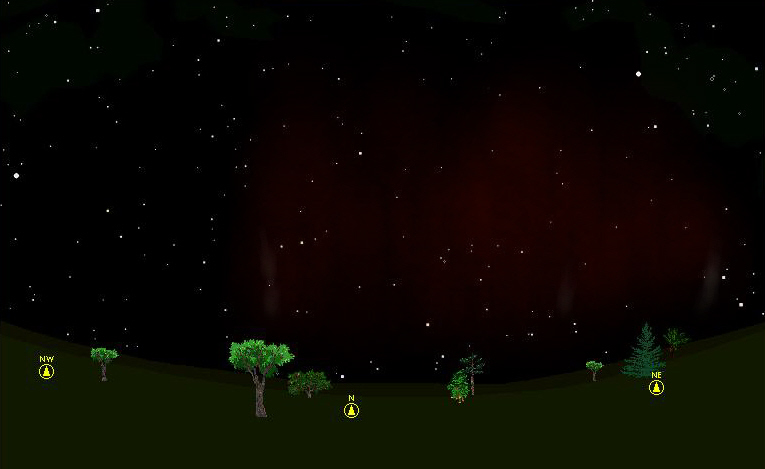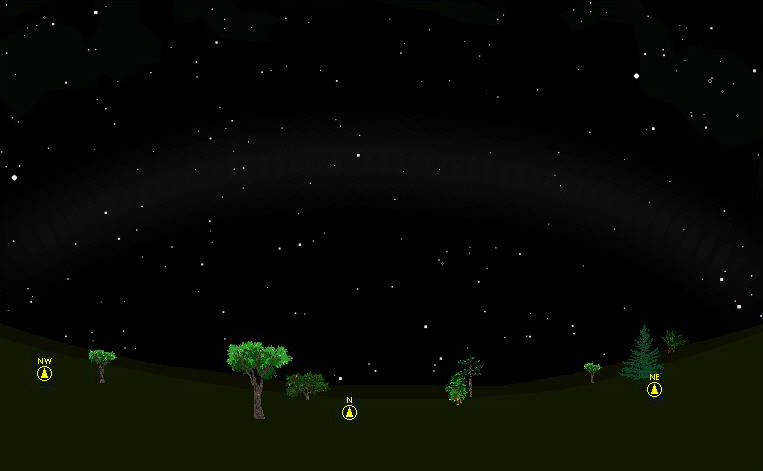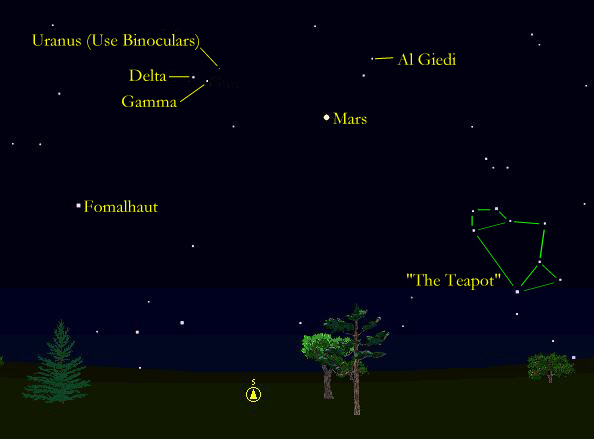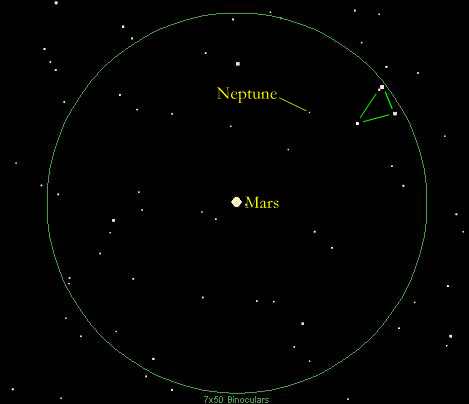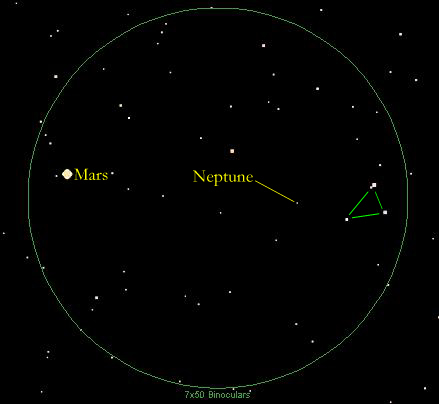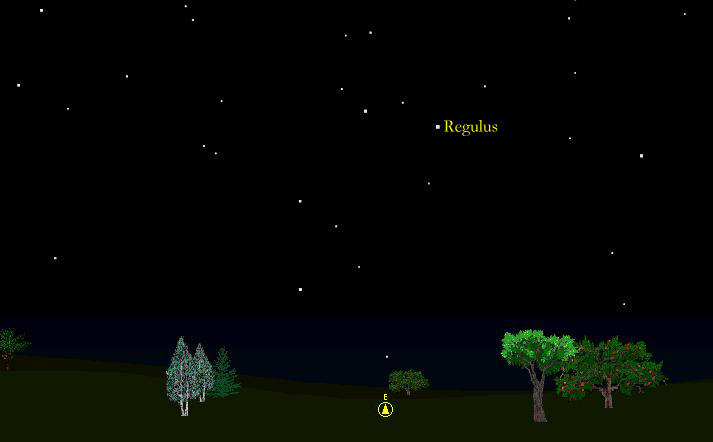Back
The November 5th Display of the Aurora Borealis
The sky at 9:15pm November 5th, from our farm at Franklin, Tn. The night of November 5th we had a beautiful display of the Northern Lights, very rare for this far south and the only one I've ever seen. Our display was caused by a Class X solar flare that occurred on November 4th. For more information about the November 4th flare, go to www.sel.noaa.gov/today.html.
The sky at 9:45pm November 5th, from our farm in Franklin, Tn.
Prowling the edges of the solar system - Finding Neptune and Uranus in binoculars This month the planet Mars is racing through the faint stars of Capricornus, the sea goat, after zipping through the stars that mark the "teapot" in Sagittarius in September. During the month of November, we're going to use Mars to guide us to the two most remote "gas giants" of the solar system, Uranus and Neptune. The week of November 5th, bright Mars will be in the same binocular field of view as Neptune. By the end of the month, Mars will have traveled across Capricornus and will be in the same binocular field of view as Uranus. Uranus was discovered on March 13, 1781 by William Herschel, with a 6" diameter reflecting telescope. Over the next few decades observers noticed that Uranus moved as if something, perhaps another unseen planet, was influencing its movements. Two brilliant mathematicians, John Couch Adams of England and Urbain Jean Joseph Leverrier of France, independently analyzed the movements of Uranus. Both predicted that an unseen planet should be found in the constellation of Capricornus, within a few degrees of the star mu Capricorni. Adams was unsuccessful in getting astronomers in England to look for the planet. Leverrier sent his observations to the Urania Observatory in Berlin, Germany. The observatory received his request on September 23, 1846 and began looking for the planet that very night. Johann Gaul was the astronomer assigned to the search. He was assisted by Heinrich Ludwig d'Arrest, a graduate student, who suggested they use a recently completed star map of the area in Capricornus to aid in the search. That evening Gaul was stationed at the telescope and he called off the positions of each star he encountered to d'Arrest. The graduate student sat at a nearby table illuminated by a lantern (shielded from the telescope) and checked each star's position on the chart. After less than an hour of searching, Gaul called out the position of an 8th magnitude "star" to which d'Arrest replied, "Nicht auf der Karte" ("Not on the chart"). The "star" that was not on the chart was in fact the planet Neptune. The unseen planet had been found. In the intervening 155 years from then to now Neptune has yet to make a complete revolution around the sun. It will return to it's discovery position around 2010. The picture below shows the view south on November 5th, 2001 at 6:00pm. [Note: For finder charts to print out and take with you outside, click here.] First locate Mars. It will be a little west of due south, and will be bright and have an orange tint. The only other bright object you might confuse it with is Fomalhaut, the brightest star in Piscis Austrinus, the Southern Fish. It will be further to the east, lower, and will not have the orange tint that Mars has. Practice finding Mars in binoculars. The easiest way to do this is to raise the binoculars up to your eyes without ever taking your eyes off Mars. This practice will pay off when you try to find fainter, less obvious objects. While you are waiting on the sky to become completely dark, look at Al Giedi (The Goat), above and to the right of Mars. Al Giedi is a wide double star and if you look closely you may be able to see it as a double star with the naked eye. If you put your binoculars on it, it is an obvious double star. Now find delta and gamma Capricorni.
Uranus, as shown in the image above, makes a triangle with delta and gamma. For a detailed finder chart to print out and use with your binoculars, click here. In binoculars Uranus will look like a faint star. At times it is barely discernable to the naked eye but very clear skies are needed. To confirm that you have seen it, you need to check what you see to the binocular chart for November 5th, then check the position of Uranus against the background stars in the field at the end of the month using the binocular finder chart for November 30th. The planet should move slightly as shown on the charts. You will find Neptune more of a challenge, since it will appear quite faint in binoculars. I can see it very distinctly in my 8x30 birding binoculars, so with care you should be able to locate it. At 6:30pm on November 5th, put your binoculars on Mars. You should see something like the image below. Pay particular attention to the small triangle that I've outlined in green. You will find Neptune by looking at it's position relative to this triangle and to Mars. For a finder chart to print out, click here. You will see Neptune better if you do not look directly at it. Look instead slightly to the right of its position, perhaps at the tip star of the triangle of stars outlined in green. This technique, called "averted vision," lets the light from Neptune fall on the part of your eye that is more sensitive to faint light. Mars at 6:30pm November 5th (Binocular View) Since you may not get a chance to look for Neptune on the 5th, I'm also putting in a chart that shows the position of Mars and Neptune on November 10th. On other days in the week Mars will be between these two positions. Again, note the position of the triangle of stars outlined in green. Don't forget to go back at the end of the month and verify that Neptune has changed position. November 30th binocular finder charts for both planets are included with the rest of the finder charts. Let us know (contact us!) how your search for these two denizens of the outer solar system went.
The Leonid Meteor Shower Mark your calendar for the early morning hours of Sunday, November 18th. This is the time that this year's Leonid meteor shower is supposed to peak. The actual peak is predicted to occur at 4:00am CST but I recommend spending as many of the morning hours outdoors as you can till daybreak, I also recommend that you check the skies around 3:00am the day before on November 17th, just in case the predictors are wrong. We checked the skies the day before the predicted peak in 1998 and had a truly amazing display of bright fireballs, some leaving trails that lasted for minutes. We watched transfixed until dawn. The image below shows the view looking east at 2:00am on the morning of November 18th. Look for the bright star Regulus that marks the bottom of the "sickle" that forms part of the constellation Leo. The radiant of the shower, the point where the meteors appear to radiate from, is within the "sickle." Click here for a finder chart to print out and take outdoors.
We take a couple of folding lounge chairs outside with us along with some warm blankets and set them up facing east. Dress warmly - it can be pretty chilly in the predawn hours. Do not take the lounge chairs out in advance - they may be covered with dew by the time you observe. A thermos full of warm coffee or hot chocolate makes everything even better. From that point on you can just sit back and enjoy the show.
Leopard Frog Tadpoles Finally, a quick note on the fall breeding Leopard Frogs in our pond this year. We now have a nice population of tadpoles, now about 1/2 inch long. So far our pond is still holding about six inches of water, so they may have a chance. We have heard them calling again on nights in November. All images used in these notes were prepared with Starry Night Pro software.
|
